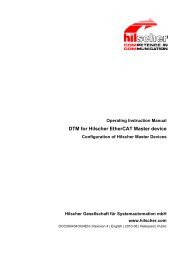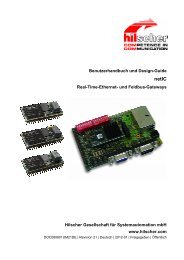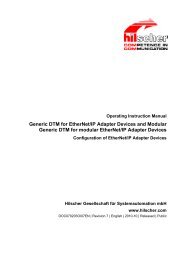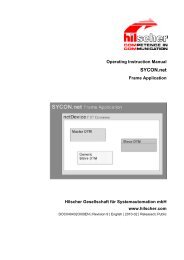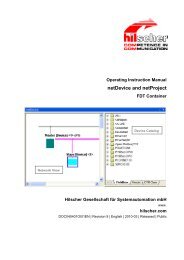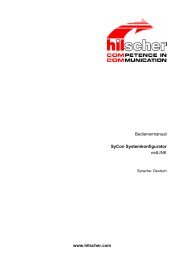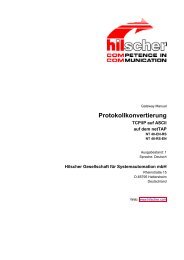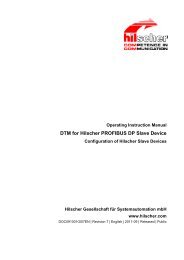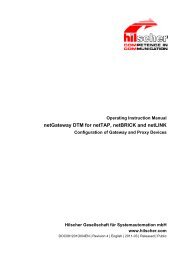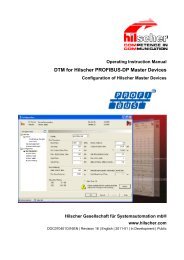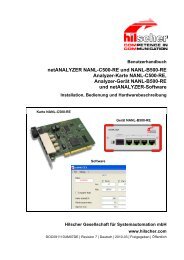cifX Communication Interfaces Real-Time Ethernet - Hilscher
cifX Communication Interfaces Real-Time Ethernet - Hilscher
cifX Communication Interfaces Real-Time Ethernet - Hilscher
Create successful ePaper yourself
Turn your PDF publications into a flip-book with our unique Google optimized e-Paper software.
LED Descriptions 206/274<br />
8.6 EtherNet/IP Adapter (Slave)<br />
The subsequent table describes the meaning of the LEDs for the <strong>cifX</strong><br />
<strong>Communication</strong> Interface <strong>Real</strong>-<strong>Time</strong> <strong>Ethernet</strong> (Slave) when the firmware of<br />
the EtherNet/IP Adapter (Slave) protocol is loaded to the device.<br />
LED Color State Meaning<br />
MS Duo LED red/green<br />
Name in<br />
the device<br />
drawing:<br />
COM 0<br />
NS<br />
Name in<br />
the device<br />
drawing:<br />
COM 1<br />
LINK/RJ45<br />
Ch0 & Ch1<br />
ACT/RJ45<br />
Ch0 & Ch1<br />
(green) On Device operational: If the device is operating correctly, the<br />
module status indicator shall be steady green.<br />
(green) Flashing Standby: If the device has not been configured, the module<br />
status indicator shall be flashing green.<br />
(red) On Major fault: If the device has detected a non-recoverable<br />
major fault, the module status indicator shall be steady red.<br />
(red) Flashing Minor fault: If the device has detected a recoverable minor<br />
fault, the module status indicator shall be flashing red. NOTE:<br />
An incorrect or inconsistent configuration would be<br />
considered a minor fault.<br />
Flashing Self-test: While the device is performing its power up testing,<br />
(red/green)<br />
the module status indicator shall be flashing green/red.<br />
(off)<br />
Off No power: If no power is supplied to the device, the module<br />
status indicator shall be steady off.<br />
Duo LED red/green<br />
(green) On Connected: If the device has at least one established<br />
connection (even to the Message Router), the network status<br />
indicator shall be steady green.<br />
(green) Flashing No connections: If the device has no established<br />
connections, but has obtained an IP address, the network<br />
status indicator shall be flashing green.<br />
(red) On Duplicate IP: If the device has detected that its IP address is<br />
already in use, the network status indicator shall be steady<br />
red.<br />
(red) Flashing Connection timeout: If one or more of the connections in<br />
which this device is the target has timed out, the network<br />
status indicator shall be flashing red. This shall be left only if<br />
all timed out connections are reestablished or if the device is<br />
reset.<br />
Flashing Self-test: While the device is performing its power up testing,<br />
(red/green)<br />
the network status indicator shall be flashing green/red.<br />
(off)<br />
Off Not powered, no IP address: If the device does not have an<br />
IP address (or is powered off), the network status indicator<br />
shall be steady off.<br />
LED green<br />
(green) On A connection to the <strong>Ethernet</strong> exists<br />
(off)<br />
Off The device has no connection to the <strong>Ethernet</strong><br />
LED yellow<br />
(yellow) Flashing The device sends/receives <strong>Ethernet</strong> frames<br />
Table 55: LEDs EtherNet/IP Adapter (Slave)<br />
<strong>cifX</strong> <strong>Communication</strong> <strong>Interfaces</strong> <strong>Ethernet</strong> | Installation, Operation and Hardware Description<br />
DOC060501UM30EN | Revision 30 | English | 2011-06 | Released | Public © <strong>Hilscher</strong>, 2006-2011




